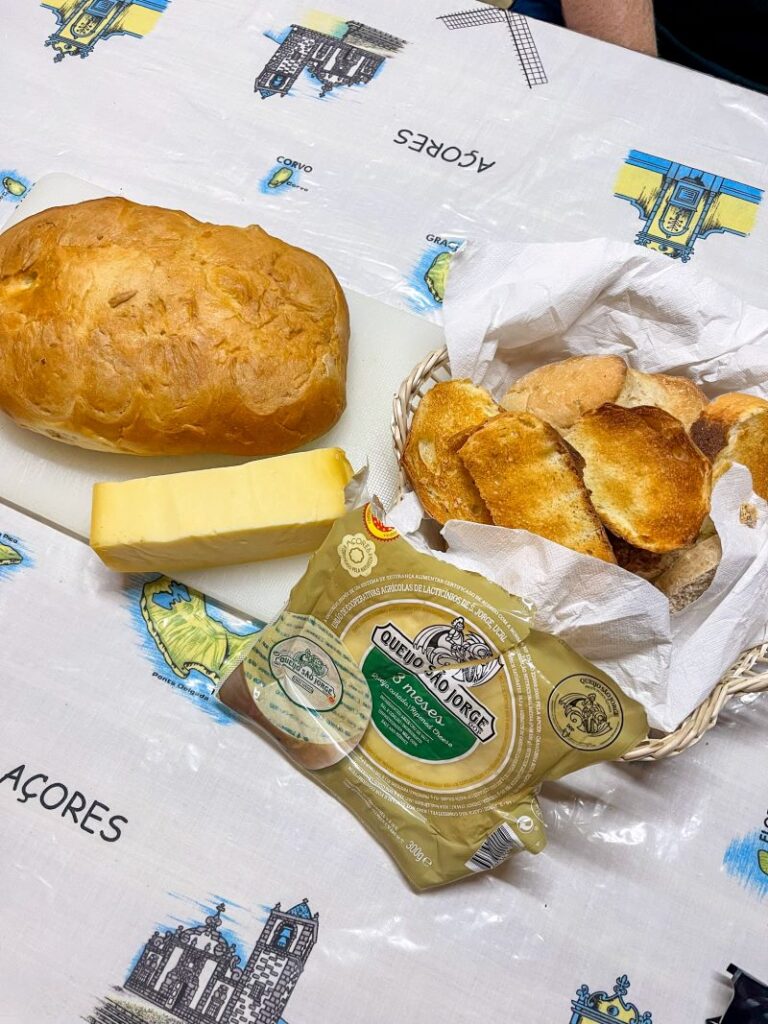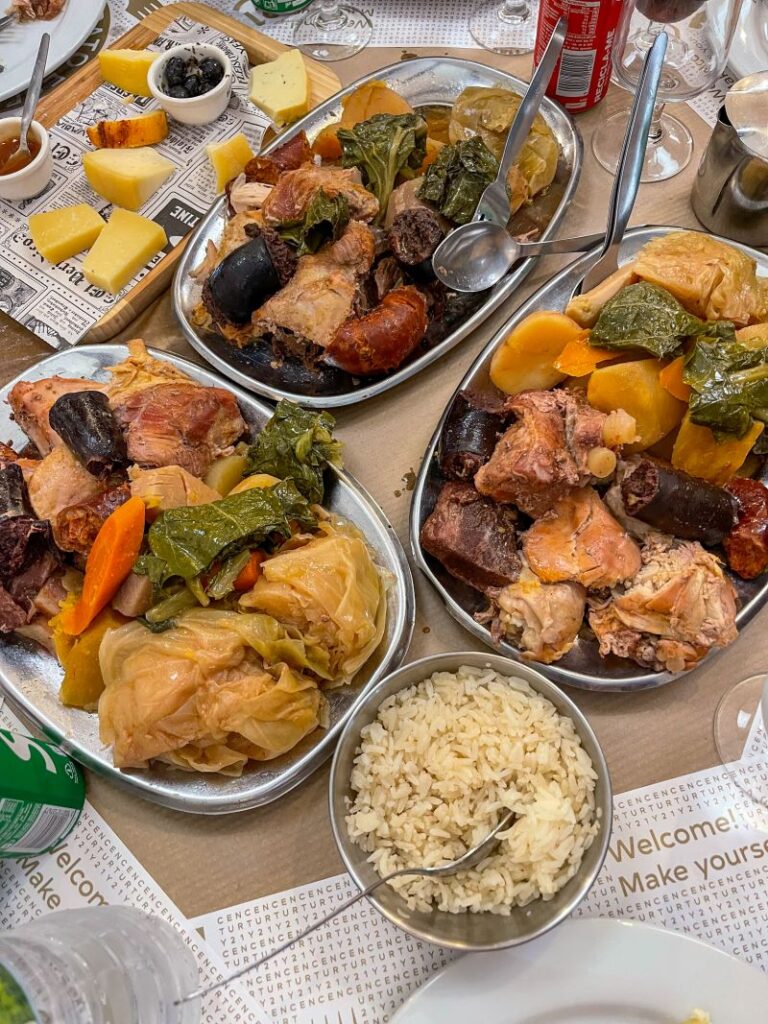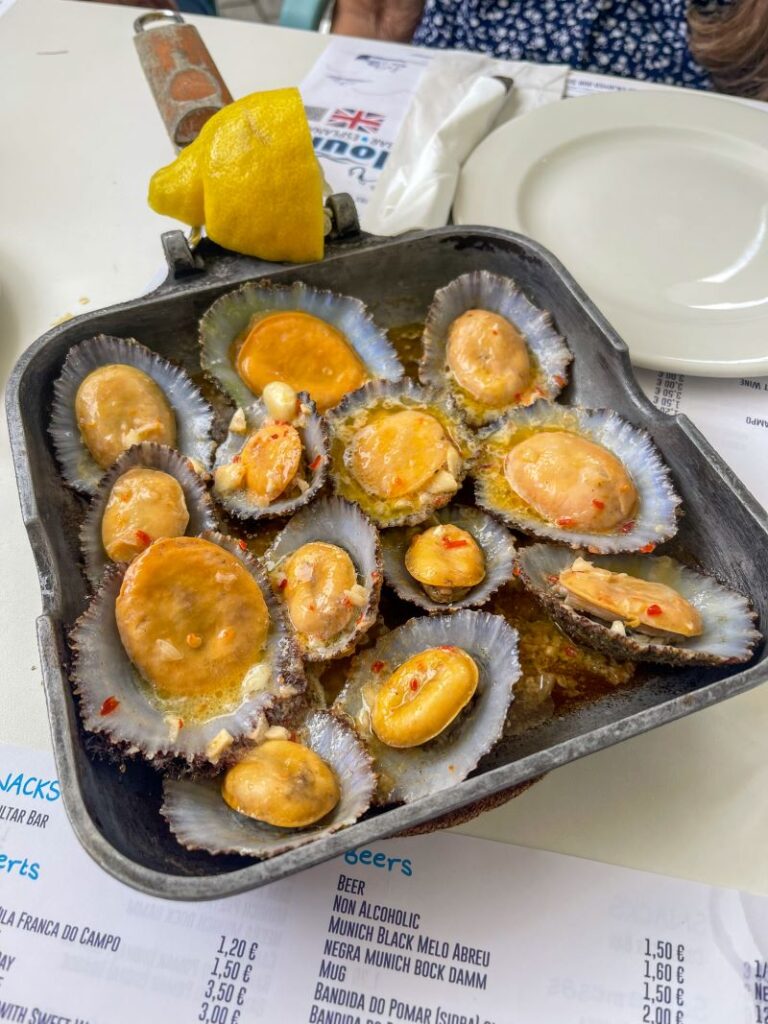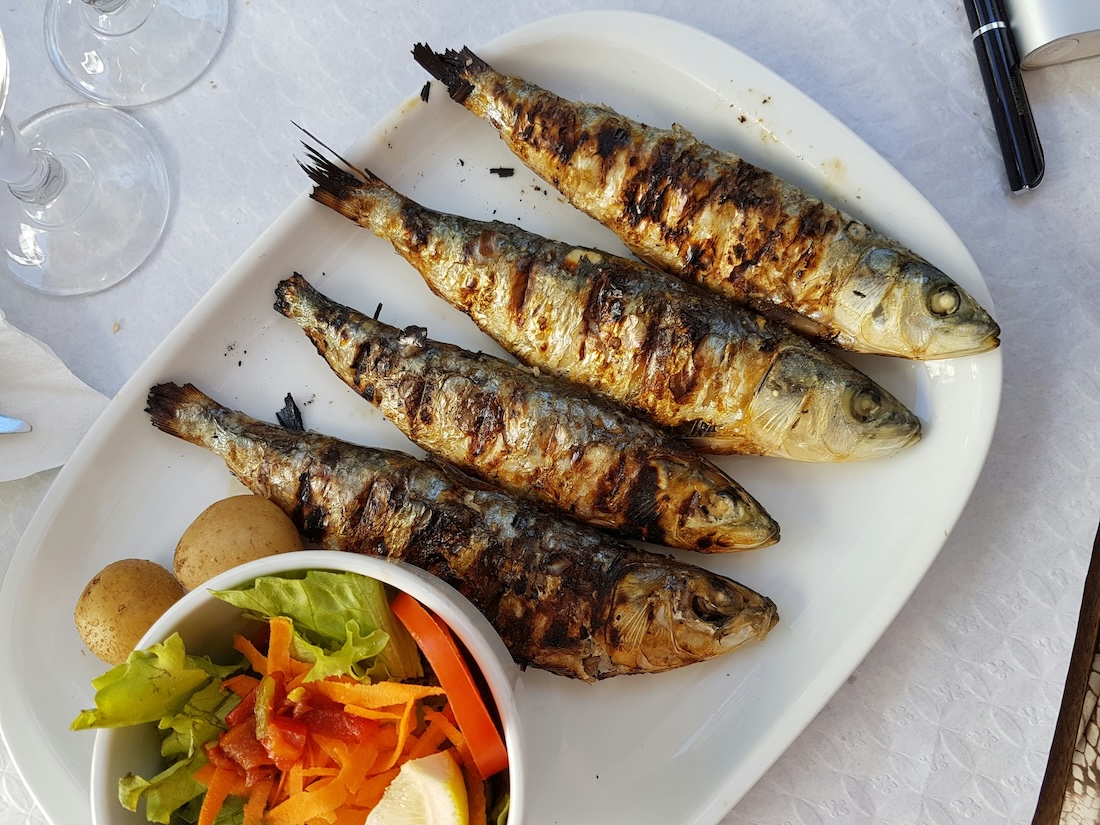Disclaimer: This post may contain affiliate links, but all content is based off our own opinions and experiences. We may receive a commission from purchases made through the links enclosed at no additional cost to you!
Azoreans love their food. It’s such an integral part of the culture that you’d be amiss not to indulge in it yourself. From fresh seafood to traditional delicacies, this must-try food in the Azores celebrate the bounty of land and sea.
Staple Foods in the Azores
I have to start with the staples of any Azorean meal: bread and cheese (pão e queijo). Need something for breakfast? Pão e queijo. Want an appetizer before your meal? Pão e queijo. Dessert after your meal? Pão e queijo. Bread and cheese is the answer to all.

Pão (bread)
Bread is a staple of Azorean cuisine and will likely (and should) be part of every meal. Whether it’s bread and cheese for breakfast or a side of bread with some warm soup, you need to try some of the different types of Portuguese bread. Some popular ones and my favorites are papo secos (bread rolls), pão de milho (corn bread), and massa sovada (sweet bread). These breads are a taste of Azorean comfort that will leave you craving more.
Queijo (cheese)
No Azores trip would be complete without sampling some delicious locally-made cheese. One popular type of cheese is queijo fresco, or fresh cheese. This is a creamy and mild cheese that is often paired with bread.
For the famous cheese of the Azores though, head over to São Jorge. The island of São Jorge produces three of my favorite Portuguese cheeses: Queijo São Jorge, Beira, and Topo. The most renowned of these cheeses is queijo São Jorge which has been crafted on the island for centuries. Made from raw cow’s milk and aged for a minimum of three months, this semi-hard cheese boasts a bold flavor with a creamy texture.
You can even visit the two cheese factories on São Jorge island in the towns of Beira and Topo to learn more about the cheese-making process and buy some for yourself. Many visitors take home the local cheese as a souvenir to share with friends and family. No matter which cheese you try, pair it with a glass of Azorean wine for an indulgent experience.
Meat
Beef and pork are part of almost every meal in the Azores making it perfect for meat-lovers. These must-have dishes will give you a glimpse into the culinary delight of food in the Azores.

Cozido das Furnas (Furnas Stew)
From the volcanic landscapes comes this delicious dish of Furnas stew, or cozido das Furnas. Make your way over to the town of Furnas on São Miguel island to taste this delicacy. The natural steam of volcanic vents cooks this traditional stew of meat and vegetables. The dish simmers underground for hours, resulting in tender meat and flavorful broth. The most popular restaurant to try this dish, and a place I enjoy, is Restaurante Tony’s.
Bifana (pork sandwich)
The bifana is a sandwich featuring thinly sliced marinated pork seasoned with garlic, paprika, and white wine served on a bread roll. The sandwich is a quintessential street food of the Azores that can often be found at festas and bullfights. Be sure to grab one at one of the local celebrations or even at food shacks that you can find around the islands.
Prego (beef sandwich)
The prego looks like the bifana but features beef instead of pork for the meat. It can also be garnished with onions, lettuce, and sometimes a fried egg! The prego can also be a street food but is also often found on restaurant menus.
Linguiça (sausage)
Linguiça is a traditional Azorean sausage made from pork seasoned with garlic, paprika, and other spices. Azoreans serve linguiça in various dishes or on bread as a linguiça sandwich.
Morcela (blood sausage)
Some people love it, some hate it. Nonetheless, morcela, or blood sausage, is a popular dish among Azorean cuisine. Made from pork blood, fat, and spices, morcela cooks until tender and flavorful, then stuffed into casings and grilled or fried.

Sopas do Espírito Santo (Holy Spirit Soup)
I grew up eating Sopas do Espírito Santo, or Holy Spirit Soup. Although it’s not the fanciest meal, it’s one of my favorites. This dish is deeply steeped in tradition, religion, and the community spirit of the Azores. The hearty soup, consisting of bread, meat, and cabbage, is served during the Holy Spirit Festivals (also known as festas). As it’s always offered for free to the community during festas, it acts as a symbol of generosity, sharing, and hospitality in Azorean culture.
Bife á Regional (steak)
If you’re not interested in expanding your culinary horizons and prefer a taste of something more familiar, bife á regional is the way to go. This juicy and flavorful steak is made from high-quality beef and is often served with fries, rice, a fresh salad, or even sometimes a fried egg. For the best bife á regional, head over to São Miguel island. This hearty and satisfying dish is sure to please meat lovers.
Alcatra (beef stew)
Alcatra, or beef stew, is made with chunks of beef, onions, garlic, spices, and red wine. The dish cooks slowly until the meat falls apart and is full of rich flavor. The dish is most famous on Terceira island and is worth trying to indulge in a hearty meal.
Seafood
With 9 islands in the middle of the Atlantic Ocean, of course, the Azores is a seafood-lovers paradise. Menus at almost any restaurant around the islands feature freshly caught seafood. Here are a few dishes that will give you a taste of the bounty of the sea.

Lapas (limpets)
Lapas are limpets that you can eat raw or grilled. This dish is as Azorean as it gets. I’d recommend leaning towards the grilled limpets, or lapas grelhadas, if it’s your first time trying them. These small limpets are harvested from rocky shores and then grilled with garlic, butter, and spices. Don’t forget to pair it with a squeeze of lemon. Locals consider this dish a delicacy, so you should taste them at least once while trying food in the Azores. In full transparency, I don’t enjoy this dish, but it’s not for everyone.
Peixe (fish)
Of course, you have to have some fresh fish while visiting the Azores. From tuna to grouper, Azorean fish is a prominent part of local cuisine. You will likely find some fish dishes on every restaurant menu in the Azores.
Chicharros fritos (fried horse mackerel)
Another favorite among locals is chicharros fritos, or fried mackerel. These small fish are often coated in seasoned flour and fried to a golden crisp. Locals eat the fish whole from head to tail, making it a bit unique to visitors unfamiliar with this type of cuisine.
Polvo (octopus)
Another delectable regional dish from the sea is anything that includes octopus, or polvo. Azoreans serve octopus in a variety of ways. It can come grilled, stewed, served in salads, and more. This is a savory delicacy that Azoreans love to indulge in.
Sweets
If you have a sweet tooth like me, this is one of the most important parts of food in the Azores. The Azores have so many different sweet treats that are different from any others I’ve seen around the world. This post would be ridiculously long to include them all so I listed a few that are most popular and my favorites.
Queijadas (tarts)
Ooh, one of my favorites! Queijadas are delectable tarts made from cheese, eggs, milk, and powdered sugar. I love the queijada de nata or pastel de nata, a flaky pastry crust filled with creamy custard topped with cinnamon (the more cinnamon, the better in my opinion). A special version of queijadas that hail from the Azores is those from Graciosa island. Queijadas da Graciosa features lemon zest and a hint of local brandy. You can also find a different variation on São Miguel called Queijadas da Vila. No matter which kind you choose or what time of day you try it, I’m sure you’ll fall in love with this taste of Azorean paradise.

Pappas Arroz (rice pudding)
Pappas arroz, or rice pudding, is a creamy, delicious traditional Azorean dessert. Made with Arborio rice, milk, sugar, cinnamon, and sometimes lemon zest, pappas arroz simmers until the rice is tender and the mixture is thick and creamy. You can eat this dish warm or cold, and you’ll often find it at festas.
Malassadas (doughnuts)
Malassadas are an addicting, sweet Portuguese doughnut. Azoreans make these fluffy fried pastries from yeast dough, deep-fry them until golden brown, and dust them with sugar and cinnamon. They are extra special when homemade by Portuguese grandmas (my grandma makes the best malassadas). Malassadas, also known as filhos, are a staple of Azorean sweets and are traditionally served during festivals, celebrations, and special occasions.
Gelado (ice cream)
If you visit the Azores in the summer, you will see ice cream sold everywhere! All the island snack shacks serve ice cream making it easy to try all the different kinds. If you want classic ice cream in a tub, Quinta dos Açores is a must. For ice cream bars and cones, there are too many to choose from. My go-to is always Magnum ice cream bars (which I first tried in the Azores long before it became a thing in the U.S.). Another great option is the Cornetto ice cream cones. In reality, though, you can’t go wrong with what you choose.
Drinks
While it’s not food, trying some of the drinks in the Azores is just as important. From coffee to alcohol to juice, there is something for everyone to try.
Café (coffee)
Like many Europeans, Azoreans love their coffee. Café culture remains strong in the Azores making any time a good time for a meia de leite (similar to cappuccino), galão (similar to latte), or a simple café (espresso). Did you know that the Azores is one of the very few locations in Europe where coffee is grown? The humidity and warm, stable temperature provide a great setting to grow the coffee. You can see this by visiting Café Nunes, a coffee plantation/garden and café on São Jorge. The popular coffee company “Delta” also started growing coffee on São Miguel island in 2023.
Sumol (soda)
Sumol is a refreshing and fruity soft drink that is a favorite among locals and visitors alike. Made with natural fruit flavors and sparkling water, Sumol is available in a variety of tropical flavors, including orange, pineapple, and more. The flavor that you need to try though is the famous passion fruit flavor.
Compal (juice)
There’s something satisfying about getting a nice, small glass bottle of cold Compal juice. This fruit juice brand is made with natural fruits and offers a variety of flavors like orange, pineapple, mango, and, of course, the popular passion fruit.
Super Bock/Sagres (Portuguese beer)
One thing you’ll learn about Azoreans is that they enjoy their beer. Whether it’s 11 am or 11 pm, any time is a good time for a beer in the Azores. Super Bock or Sagres are Portugal’s most popular beer brands making them must-tries while visiting the Azores. Super Bock and Sagres are the perfect companions to the laid-back atmosphere of the Azores. Not to mention, you can get a cup of beer for only €1 – €2 at most local festas and bullfights!

Vinho (wine)
It’s not only beer that Azoreans like to drink. Wine is also extremely popular in the Azores. You are likely never to be at a dinner table with locals and there not be wine on the table. The Azores produces unique wine with grapes grown in the volcanic soils of the islands. The landscape of the Pico island vineyard culture was even classified as a UNESCO World Heritage site. From crisp whites to full-bodied reds, Azorean wine showcases the unique landscape and winemaking traditions of the islands.
Are the Azores vegetarian-friendly or vegan-friendly?
You may have noticed that the majority of this list is not very accommodating to vegetarians or vegans. As a region that consists of farmland and farmers, the Azores prides itself in its local ingredients including meats, seafood, and dairy products. So, is food in the Azores vegetarian-friendly or vegan-friendly? The short answer is “not really”.
But, don’t let it deter you from visiting!
Some islands in the Azores, mainly the larger islands, actively work towards accommodating such dietary restrictions. My recommendation for vegetarians or vegans is to visit São Miguel where restaurants are more likely to accommodate dietary restrictions. Another option is to find accommodations that provide access to a kitchen so you can cook your own meals. The islands’ grocery stores are abundant in fresh produce making it easy to prepare vegetarian or vegan meals.
Summary
As you explore the Azores, be sure not to overlook the culinary scene this region has to offer. The hearty and rich dishes are sure to be unique and can only help you connect deeper with the local culture. Through the food in the Azores, you can further understand and celebrate Azorean traditions and heritage.

